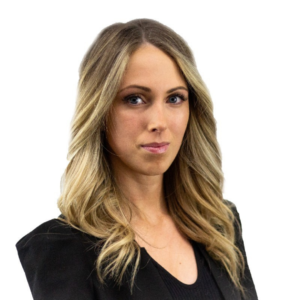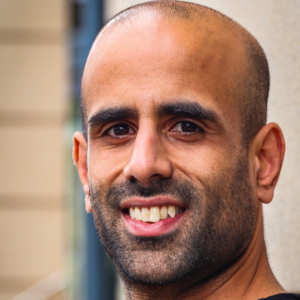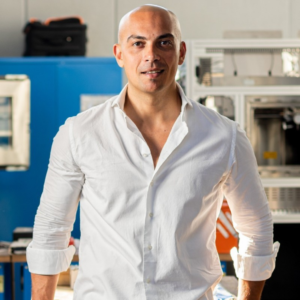As a result of the outbreak, many businesses were forced to pivot and adjust to changing market conditions. Some were able to make the necessary adjustments, while others were forced to shut down. We spoke with 20 business owners and leaders to learn how they made changes to their companies and all the challenges they encountered during the pandemic.
We’ll also go over some strategies you can use to overcome any obstacles that come your way.
INTERVIEW HOST
Hello, my name is Jerome Knyszewski, I’ll be the host of your interview today. I am the CEO of HeavyShift. My specialties are online reputation marketing and SEO. Looking forward to reading your insightful answers and publishing your featured interview.

Table of Contents
The question we asked:
What is the greatest, unexpected challenge you faced with your business, that you’d like to warn new entrepreneurs about? Please share your advice on how to overcome it.?

David Ciccarelli
You’re going to hear no a lot. “But that’s not unexpected.” Sure, you probably expect to hear no. But you likely aren’t expecting to hear no quite as often as it actually happens, and it can be a devastating blow to morale to new entrepreneurs after hearing it over and over and over (and over) again.
Here you are, a new entrepreneur with a fantastic new idea or improved way to do something, and you just know it’s going to be revolutionary—or, at the very least, successful enough to become a profitable business. You’ve done your research, you’re ready to pitch to investors, you’re ready to find business opportunities and partners, and you’re ready to take on the world, bolstered by hope and excitement.
And then the NOs start rolling in. “It’s not a good time.” “We don’t typically take on projects like this.” “This isn’t a good fit.” “You just don’t have the data to back this up.” “Do you really think this will work?” “Is there even a market for this?” These statements keep piling up, most often accompanied by a resounding “no.”
Be ready for this. Be ready to hear no 50 times for every yes. And, perhaps most importantly, don’t take no for an answer so readily. As a young, green entrepreneur, hearing “no” can be disheartening and is often easily accepted, because who are you to be questioning established business folks on their “no”?
Sometimes, no means no and the door is closed, but in business, “no” can actually mean “not right now” or “there’s no room in the budget this year.” Hearing “no” can actually be an invitation to get creative and find ways that your proposition will be of benefit to your intended business partner or investor without breaking the bank or creating additional work on their end.
Rejection can also be an opportunity for you to re-evaluate your position and the information you’re putting forth. Are you missing something? Does something need to change in order to better resonate with your intended audience? Analyzing the potential shortcomings in your planning will help you to better approach it next time.
Better yet, don’t be afraid to ask for genuine and transparent feedback from those who said “no” in the first place. Ask for clarity and an explanation as to what exactly made them reject your proposal so you can take that away, fix it (if possible), and come back stronger. In short, seek ways to turn “no” into “yes” and don’t accept defeat so easily.

Samantha Odo
I am Samantha Odo, a licensed real estate expert at Precondo. We take pride in adhering to high-quality journalistic ethical guidelines, and we retain journalistic integrity to assist in making the best decision per necessities.
With the pandemic and the following restrictions, entrepreneurs and business owners faced several challenges. I, as a realtor, was one among many others who stuck at home, not able to mark my presence in the industry. As a realtor, it was challenging for me to meet both sellers & buyers.
However, technologies stepped in as a big help. Meeting my clients online and giving them a virtual tour of properties they are interested in was convenient for me. It resolved many problems I was facing.

Loren Howard
When I first started as an entrepreneur I did not understand the importance of marketing your business. You can do everything ‘technically’ but without the proper marketing and sales funnel in place your business will never take off. Invest time and money upfront into marketing your business for a successful launch!

Alex Gastle
As entrepreneurs we are excited about our business and what it can do for paying customers. This excitement and the potential we see is often what drives us in the early days to work harder and persevere through the tough times getting started.
In my experience, the side effect of this excitement is that entrepreneurs struggle to remove themselves from their own excitement and view their business from their eyes of their target customer or user persona. Tech entrepreneurs love to focus on the fancy features of their new app in everything they do without having a crystal clear understanding of the problem their product solves and how their target users are solving that problem now, without their new app.
This doesn’t mean researching your competitors, that’s different because you’re all trying to solve the problem in a new way. Speak with as many people as you can to discover what they are using now to solve the problem and then apply that back to your own business.
Your perspective will change on things like what features are most important, often the features that an entrepreneur is most excited about aren’t the features that target users will gravitate to. If you can get a handle on this, your product development time, sales and marketing will all become much easier.

Adam Millman
As an entrepreneur, being able to be nimble is key. You quickly learn that you can’t get too attached to certain ideas, and being able to pivot accordingly is an incredible strength for any business.
More often than not, the first iteration of any product/business may not be the best — it takes countless versions, tests, and ideas to get to the end product. Down the line, you realize how necessary every step was in order to get to your final product/business.
My advice on how to pivot with the most ease is to build a strong team. A cohesive team that compliments each other’s strengths is a perfect recipe for a nimble, quick-thinking business. You need several voices trained onto one razor-sharp vision, bringing perspective and ideas to the table without clouding the end goal.

Lisa Richards
Constant fatigue was perhaps the most unexpected challenge I encountered when starting my business. The crazy hours, the intense work involved, and the pressure to make sure the business succeeded really took a toll on me, physically, emotionally, and mentally.
However, as the business grew, I was able to find a pace that allowed me to keep the business thriving while still managing to protect my wellbeing. I also learnt how to delegate more effectively, which enabled me to rest more, and to focus on the areas in my business where I could make the biggest impact.

Lillian Brummet
I’m not sure how far you want the story to go back but here is a brief overview of my life: My mom married 5 times; 2 of those were abusive… and so I was on my own at 13.5 years old. My 2 older brothers were on their own before I was, both left at 16.
I supported myself, paid rent, worked hard labour jobs to get by and partied hard – often sheltering young people who needed to get away from their home life, giving them a place to stay until they figured things out.
At 20, I put myself through a university level of grade 12, meaning I took the extra hard, more advanced courses in math, biology and science, etc. so that I could qualify for university. At the time I was thinking of becoming a biologist. Met and married my husband Dave around this same time, and started a business providing home maintenance services for upper-class clients.
Ran that successfully for 6 years before being in the middle of a 3-car pileup that had me in full-time physio (5 days week, 4-5 hours per day) for over a year. I had to close my business – and fell into chronic depression, something I struggled with most of my life, and developed an anxiety disorder (which I struggle with today). At that point I changed directions – began studying the world of writing as a profession, and haven’t looked back yet.
I chose this career because I needed to feel like my life had value, that I was leaving a positive legacy and using every moment I was given to the best of my ability. I entered this field in 1999 as a freelance writer, later becoming a staff writer, columnist and assignment writer.
My greatest adversity early on in the career was having the confidence that my voice had value in the clammer that already existed. I overcame this by ensuring what I wrote was unique – researching recent writings about the topic to find out what was missing, what wasn’t addressed, what I did or did not like about the published materials, and then I would find an angle that I could write about filling a negative gap.
Both my parents (mom & step dad) committed suicide in 2009, forcing us to reconsider the direction of our lives and reminding us of the tragedy in waiting for a tomorrow that may never happen. Instead of buying a home in the big city, we moved to a smaller city about 3 hours drive from our home town.
Since then I have worn many hats; at one time I wrote book reviews professionally; donating over 700 books to our local literacy organization because of this task. I also wrote product reviews professionally, and still offer this service on our blog.
I ran a popular talk radio show for about 7 years or so; it ran 3 x per week, 1 hour per episode, called Conscious Discussions Talk Radio. Around this same time period I also ran the Author’s Read podcast for a few years. About mid-point in our career we had another crisis.
Dave had been working shift work while we both worked ourselves thin refurbishing our first home and running the business. Both of us were exhausted, diminished by the weight of heavy grief after the suicide of my parents and the cancer diagnosis of his biological father (the last of the parents).
The stress was beginning to affect our marriage. We all decided, the dad included, to move to our dream location before it was too late. Life is just too short to wait for tomorrow to live your joy.
So after a year of looking at properties we sold everything, packed up, bought a house (another fixer upper), and began our new lives here as of 2012. This also meant revamping the business so that it better represented our current projects, including a few book updates or publishing new editions. That was 10 years ago.
Since moving to our dream location (in the Kootenay Region of BC, Canada), and caregiving for the dad who passed 4-5 years ago; we have been methodically converting the abused lot over to the little park it has become – and in doing so have gained certification with bee, pollinator and wildlife organizations. Our home, too, has become energy efficient via the many upgrades we have done.
Our business donates 10% of the profits to wildlife, bee and pollinator, pet rescue and seed saving organizations. Our business includes Dave’s music studio, percussion accessory products and services, as well as numerous award-winning non-fiction books and 2 popular blogs.
In 2020 we relaunched the business with a new look, logo, colours, design, new bio’s and profiles and updated everything from social networking sites to our main website. We also launched Dave’s Drum It With Brummet blog. We realized we needed to learn better skills to deal with changing business needs.
Starting in 2020 I began taking a number of online courses to better understand SEO, Keyword Management, E-commerce and online advertising (Facebook & Amazon Ads).
In ’21 we released 2 books and due to all of the marketing and other efforts I am proud to say that we appeared in the media more than 125 times that year and our main blog, Brummet’s Conscious Blog, has had a huge increase of visits as of late.
In December (a 31-day month) we saw #143,000 visits, in January (also a 31-day month) this increased to #346,788, and so far in the past 9 days of February, we saw #134,547 visits. The blog has helped us solidify long term networking relationships and discover new ones, because of kinds of submissions and interviews that we accept.
For instance, just last month I put in a few weeks of work following up with the 940 connections we made last year. For those we had a positive interaction with, our message simply stated our gratitude and interest in continuing to network and offered a few ways we might be able to support feature them on the blog. For those who did not reply, we were able to reach out again with a slightly different approach.
I find I get about an 8% additional return on investment using last year’s work. Four years after the dad’s passing we are finally in a place where we can face the emotional journey of publishing his work. We are currently working on what we hope to be a trilogy, celebrating Dave’s late-father’s lifetime collection of poetry, short stories, family memoirs and photos.
I speculate that the first 2 books will be published late-spring ’22. This is our way of honouring his dad, and doing our part for future generations of this family. Bio: Lillian and her husband Dave are the team behind Brummet Media Group, high-fiving cheerfully as they pass each other on the way from checking off one item or other from their long to-do list.
Their business includes Dave’s music studio and percussion accessory products and graphic design work as well as numerous award-winning non-fiction books and 2 popular blogs. Find them online here: https://linktr.ee/LillianBrummet

Danny Neeson
What I’ve learned through each entrepreneurial venture is that the biggest challenge can oftentimes be yourself. When you face obstacles or challenges, your determination and work ethic are what will either make or break you. Business owners need to dig deep and face the battles within themselves to transcend beyond their self-made limitations and see the potential that others might miss.
Confidence isn’t always a natural thing; it takes strength and courage to show up every day and believe in what others won’t. Know what you bring to the table every day!

Ravi Davda
“I was young when I left my corporate job to start my first business. I was earning a great salary in a banking role, and I left it to start with nothing. If there’s one challenge entrepreneurs should know about, it’s getting through those first months or even years without taking a proper salary.
Even if/when you do make money, it’s likely that you’ll be reinvesting some, if not all, of it back into your business. This is tough, especially for people who have never been there or have always had a stable salary. It takes a lot of sleepless nights and a lot of determination. Don’t underestimate this if you’re starting a new business.”

Alessio Lorusso
My name is Alessio Lorusso (Forbes 30 Under 30) and I am the founder and CEO of Roboze (roboze.com), the most accurate 3D printing technology in the world for high-performance super polymers. Roboze is a startup based in Houston, TX, and Italy.
As an entrepreneur who has built a successful company starting in a region of the world where there are few investors (Southern Italy), attracting initial outside investors was the most unexpected challenge, and I can share some lessons learned.
Looking back, I realize that one of the reasons for my success was because I had confidence in myself and the strengths of my innovation which I built when I was 17 years old, by developing the world’s first 3D printer without belts.
This innovation, de facto eliminated the issues linked to the rubber belts regularly used in desktop 3D printers: distortion, wear, inaccurate repeatability, and the need for frequent calibrations. It was thanks to this invention that I then founded Roboze, which now employs over 100 employees, has facilities in Italy, Texas, and Germany, and has attracted numerous investors and key strategic partners.
For startups like mine that are not located in the more traditional hubs, it is a greater challenge, and it often takes longer to attract initial investors, than for startups located in Silicon Valley, Israel, or the UK. That is why, in order to start growing relying just on initial funds from my savings, I needed to outline a growth path that had very little margin for error. This can be accomplished by learning in-depth about the market you are in, having a clear vision of your goals and what it takes to get there.
Typically, especially in early stages, there are fewer people who support you, believe in you, and help you when you want to create a new innovative company with the intention to disrupt a segment of the market. So, you must be focused enough to know when to take risks, believe in yourself, have the courage to do things differently, and not be afraid of failure.
Failure must always be taken into account, it’s part of doing business. However, staying focused and having a direction that you pursue consistently (avoid the “shiny ball syndrome” at all cost) without ever losing motivation despite obstacles will allow you to grow sufficiently to become attractive to investors, wherever they may be.

Humza Khan
All of us, and especially business leaders find discomfort in uncertainty. Because of the pandemic, supply chain struggles, and labor shortages, uncertainty is more pronounced today.
Those unknowns lead to short-term myopia. Many people shy away from long-term planning in favor of immediate concerns. Uncertainty drives business owners and executives to hunker down, and customers to stop spending.
While this might feel right, failure to strategically plan and stay focused 10, 5 or even 3 years into the future can end up eroding tremendous value. The world is simply not going to end. Plan well. Be agile. Yet don’t lose sight of the milestones and goals you intelligently set in the first place.

Taylor Ryan
A risk management plan! When you run a business, be prepared for more significant losses than you initially anticipate so that the company can survive in the event of a crisis.
This was certainly one of the hardest parts of starting and running my own business. Life is full of surprises, especially in business. There’s almost certainly going to be a few expenses that you did not anticipate – tax changes, changes in the financial market, new competitors, a global pandemic.
Small businesses often generate relatively low income. Therefore, even small financial turbulences can lead to their complete collapse. It’s crucial to factor risk management into your financial plan: Be prepared for the worst, and a crisis will cost you much less. This is the best advice I can give anyone who is planning to start a business.

Ellenor McIntosh
One of the greatest challenges I’ve had to learn is effective time management. More often than not, new entrepreneurs can find all their time being consumed by the new business venture they’re pursuing. You work tirelessly to make sure this becomes a success, that you forget about everything else.
All your energy and time go into your business that can ultimately end up working against you. Pouring all of your energy into work, you forget to take time for yourself, and you realise that other important aspects of your life will eventually take the backseat.
Over the years, I have come to appreciate that less can be more, and apply this to certain aspects of my business. Overworking yourself is not adding benefit to your business’ success, but rather you’ll find yourself feeling stressed and overwrought. Learning how and when to ‘switch off’ has been such an indispensable lesson and is something I have come a appreciate more and more as my business continues to grow. Switching off can mean different things for everyone.
For me, that means taking time away from work to do a completely unrelated activity. Whether that was going out with friends, starting up a new hobby or just taking time to myself to decompress at home – carving out the time to focus on just you are something I firmly encourage all entrepreneurs to do.
I find by doing this, it can significantly affect your mental and physical wellbeing for the better. When you’re in a good mental space it reflects in the work you do. You are taking the time to ensure that you are in the best shape possible to successfully run your new business venture. Some of the methods I’ve found that has greatly helped me overcome this has been setting feasible deadlines with certain tasks and projects, and effective time allotment on tasks set for myself and others under my management.
I realised that while setting deadlines is a great start in managing my time more effectively, I also had to learn to discipline myself in sticking to them. It can be so easy to find yourself doing a little extra on that one project or working a little later than the time you set for yourself, but once you fall into the habit of constantly working overtime, it can be extremely difficult to come out of.
This is why it’s so important to implement these ‘guidelines’ for yourself near the beginning and act in accordance with them. Once you learn how to stick to the guidelines you’ve set, whether it’s to do with time management or something else you struggle with, you’ll notice how much smoother and more efficiently your business venture operates. Ellenors Bio: Just to introduce her, Ellenor McIntosh, is one of the few young, black female entrepreneurs in the UK, and is paving the way for others to follow.
Having graduated from the University of Bedfordshire with a Bachelor of Science (BSc), Biological and Biomedical Sciences, Elle has used her science background to create the formula for her innovative creation – Twipes. Twipes is the world’s first truly flushable and biodegradable wet wipe, that’s 100% plastic-free! When flushed, Twipes are completely dispersed in just 3 hours, and will fully biodegrade within 7 days. Co-founded with her long-time college friend, Al Borz, they boldly set out to start their own business.
And after 5 years of much research and development, their resilience paid off with the success of Twipes. Elle has been the recipient of multiple prestigious awards, namely the Princess Diana Award in 2017, awarded the Forbes 30 under 30 in 2020. She has even been recognised by the Mayor of London and featured in Time-out Magazine in 2021 for her (and her co-founder’s) innovative product. She is not only making strides in the entrepreneurial world as a successful young, black woman but also in the world of single-use items, with her cutting edge and ingenious creation of Twipes!

Cliff Auerswald
My name is Cliff Auerswald, President at All Reverse Mortgage, a top-rated financing and mortgage company.
The greatest challenge new business owners are going to face is when they hit the bottom of the J-Curve. At that point, business owners find out that most of their initial assumptions about their product and market are wrong, so they don’t see much return for their effort. And then the money and morale start to dry up.
In order to escape the bottom of the J-curve to enter the periods of steep growth and traction, new business owners need to be open to changing their ideas. They might need to change their ideas about the product, market, or strategy (sometimes, all three) in order to keep the company alive.

Rachel McMichael
When first starting out and trying to build an audience, it’s easy to believe that any visibility means your business is doing well, when getting in front of the right audience (those who need your product, program, or service the most) is actually the true goal.
So many beginner entrepreneurs try to create content that attracts the most people (quantity), rather than creating content that attracts their ideal customer (quality). But a popular business does not necessarily equate to a profitable business. A larger group of followers might get your business plenty of “likes”, but a group of qualified ideal customers is what will give you the sales and conversion you’re looking for.

Christiaan Huynen
Shift in people’s buying habits. The next level of online shopping has taken over the ecommerce industry. More engrossing digital experience is now the trend in selling.
Consumers are shifting into an “experience economy” wherein they want not only the item itself but also the act of the digital purchase. Products are big because of their curated content and with the influence of social media, the fear of missing out is fostered in the e-commerce business.
This trend changed the way our company designs logos, websites, brand identity and many more. An appealing graphic design is not enough to increase lead generation nowadays.

Alexej Pikovsky
“The greatest and unexpected challenge was the lack of paid traffic opportunities on platforms such as Google, Facebook, and Tiktok. Our initial business idea was to build a CBD marketplace with a diverse growth channel mix including pay per click.
Not having the ability to pass through Google and Facebook algorithms was an unexpected challenge and prevented us from growing as fast as we wanted to. The way we overcame it was by doing a lot of search engine optimization and influencer marketing. We have invested a lot into content and technical optimization, as well as building up a database of influencers.
In addition to that, we scaled up revenue from adding a services business providing value add to brands on our marketplace, as well as acquiring non-CBD brands under our alphagreengroup.com banner.”

Ryan Walton
“The most unexpected challenge for me, which applies today and when I started the business, is how obsessive you become with working and how hard it is to switch your brain off.
It’s really prevalent in my life – that addiction to work is a really big challenge because you’re suppose to live a life of balance which encompasses and embraces relationships and friendships outside of work. You can easily find, without knowing it, that your business can take over your life. My advice to new entrepreneurs would be to try and create a balanced life ahead of time before starting the business, form those positive habits and not experience burnout as a result.”

Alice Ojeda
“One of the big challenges we faced as we grew was scaling our systems. By systems I mean, how we built our website, where we hosted our subscriptions platform and our email marketing provider. When you start, it’s easy to go for the free trials and cheap start-up offers on digital providers.
It’s worth bearing in mind though the cost of switching as you grow and whether the platform you’re about to choose is the one you really want to lock your business into for the long-term. For example, we’ve migrated our subscription platform twice now and it was a real headache. To save this, do your research and choose carefully – start as you mean to go on.”

Pavel Stepanov
In the last 4 years of operation, some of the major unexpected challenges we have faced are finding and retaining good talent and leadership. It can be hard to find people who think similarly to you and want to see the company go in the right direction.
Finding employees who understand the company’s mission, and have the company’s interests in mind has been a struggle. It’s also been a challenge to find good leaders who can lead by example, be good trainers and mentors, and build up team morale and productivity.
Hiring someone can be scary, as you are taking the chance to trust them with part of your company. That’s why in the beginning, it was hard for us to let employees go, as you do invest and put faith in them that they will do well. When you let someone go, you’re letting them and yourself down, at least that’s how it felt in the beginning.
I ended up finding out that when you hire people who don’t think similarly to you, it can be harder to take on new projects together. Again, hiring was fast and easy – even fun and exciting. However, there have been times when people proved they didn’t have what it took, and it took a long time for us to decide to let them go.
For aspiring entrepreneurs that will hire someone for the first time, please keep in mind that they should not be qualified on paper only. Assess whether or not they were a good fit for the company. Make sure that the people you will hire always have the best interest of the company in mind. Bring on hard-working people who have a vision for your company and want to grow with you.


